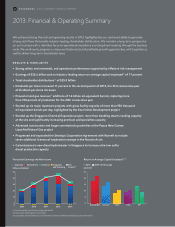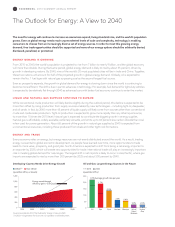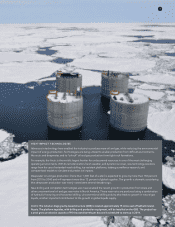Exxon 2013 Annual Report Download - page 16
Download and view the complete annual report
Please find page 16 of the 2013 Exxon annual report below. You can navigate through the pages in the report by either clicking on the pages listed below, or by using the keyword search tool below to find specific information within the annual report.
DELIVERING PROFITABLE GROWTH
Upstream: Developing Advantaged Resources
ExxonMobil’s unique combination of experience and expertise operating in difficult environments sets the stage
for project execution success in emerging countries such as Papua New Guinea (PNG). In PNG, this knowledge
has enabled ExxonMobil and its partners to surmount a myriad of challenges as they approach start-up of the
PNG Liquefied Natural Gas (PNG LNG) project in 2014.
The $19 billion development in PNG will produce
6.9 million tonnes per annum (MTA) of LNG for shipment
to international markets as well as domestic sales. It is
designed to tap world-class reserves from eight separate
fields spread across approximately 120 miles. The project
includes the construction of a 960-million-cubic-foot-
per-day gas conditioning plant in the mountainous
Southern Highlands, a liquefaction plant near Port
Moresby, and 434 miles of pipeline (253 miles subsea)
connecting the two. Successful project development,
start-up, and future operations rely on strong relationships
with host governments, local communities, and partners,
as well as thoughtful planning and proper employment of
project management fundamentals.
WORLD-CLASS EXECUTION
Through a disciplined approach to project management, the project is well positioned to start up in 2014 despite difficult
local conditions. The challenges included zero to low visibility, minimal pre-existing infrastructure, incredibly steep slopes
(up to 50-percent grade), as well as geotechnical constraints such as volcanic soil and fault lines. The onshore pipeline,
for instance, crosses five faults, which required strain-based-designed pipe and specialized installation procedures.
An airfield was constructed in the Highlands to airlift facility modules to build the gas conditioning plant. During the
airfield’s construction, more than 9 million cubic meters of earth were moved, and the area experienced enough rainfall
to cover the site with 31 feet of water. In addition to technical challenges, a project of this magnitude required global
experience to successfully manage a workforce of approximately 20,000 people (speaking more than 40 different
languages). Papua New Guinean nationals comprised more than 40 percent of the workforce at its peak.
The project team is preparing for production as construction activities near completion.
A vessel is transported to the Hides gas plant site through
the unique PNG terrain.
14 EXXONMOBIL 2013 SUMMARY ANNUAL REPORT
























